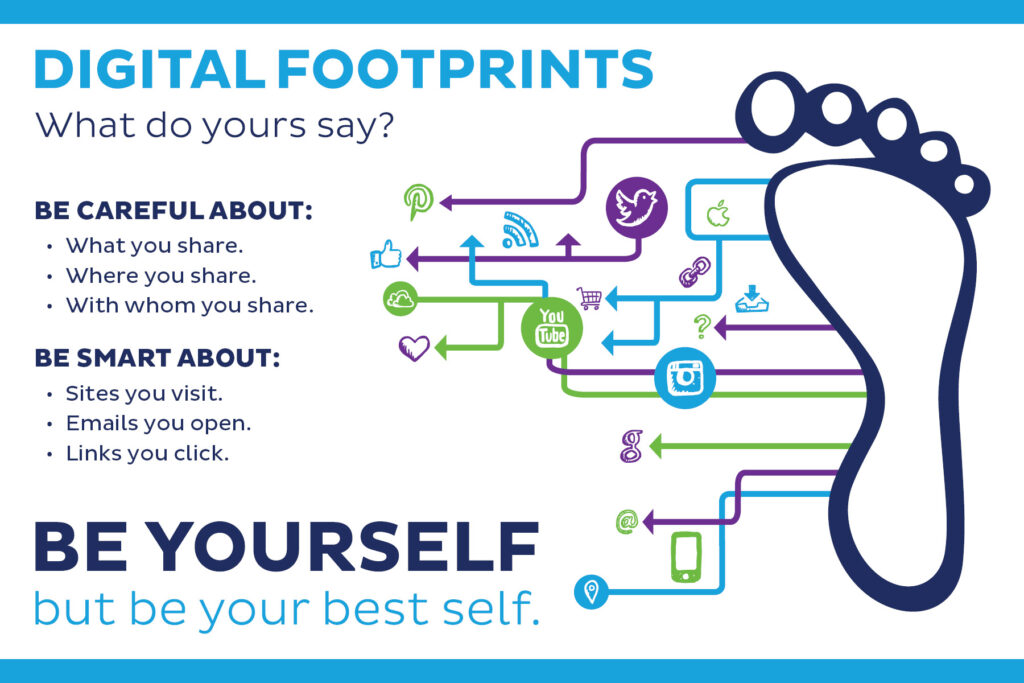The topic of the fourth debate was educators’ and schools’ responsibility to help students develop a digital footprint. It was a really interesting debate but knowing the meaning of “Digital Footprint” is so essential before any further steps. According to one article, “Digital footprint sometimes called a digital shadow or an electronic footprint – refers to the trail of data you leave when using the internet. It includes websites you visit, emails you send, and information you submit online. A digital footprint can be used to track a person’s online activities and devices. Internet users create their digital footprint either actively or passively”.
The following picture adopted from a website can clarify what “Digital Footprint” means in a really short and comprehensive way:

In my opinion, in today’s digital age, it is important for educators and schools to help their students develop a positive digital footprint. Additionally, based on its mentioned definition, “Digital Footprint” can include a social media activities, online purchases, and any other online activities that leave a trace. In this blog post, I will write about its positive and negative sides.
Pros:
One of the most important positive sides of this topic is that it encourages students to develop a digital footprint that can promote digital citizenship, which is crucial in today’s world. Digital literacy means having the ability to use digital technology in a proficient and responsible manner. One excellent way to enhance and develop these skills is engaging in the creation of these contents. A positive digital footprint can also build a positive online reputation. They can create digital content that shows their skills, interests, and achievements. It leads to creating a positive online presence which is beneficial for students, especially when they apply for colleges and jobs. It is critical to mention that creating digital content helps students to find more opportunities to grow and learn. Different examples of creating digital content are creating videos or writing blog posts which help students improve some of their skills including writing and communication.
A good example can be a student who started a blog where she writes about her experiences with mental health. She shares her personal struggles and offers advice to others who may be going through similar challenges. Her blog has gained a large following and she has received messages from people all over the world thanking her for her honesty and inspiration.
Cons:
If educators and schools do not have a responsibility to help their students develop a digital footprint, there could be several negative consequences. One of the potential drawbacks can be the lack of digital literacy which means students may lack the necessary knowledge and skills to navigate the digital world. Therefore, they may be unaware of the potential risks and may not understand how to manage their online presence. Another one is the danger of cyberbullying. Students may be more vulnerable to cyberbullying, which can have a significant negative impact on their mental health and well-being. The next one is about reputation damage. Pupils might unintentionally post inappropriate contents that harm their reputation for future opportunities such as jobs and colleges. The last two instances can be exposing to inappropriate contents and lacking privacy. The former refers to exposing inappropriate or harmful contents online, which can negatively impact students’ development and well-being and the latter means that they can put themselves at risk by sharing personal information online.
One real-life example of the negative consequences of an unmanaged digital footprint is the case of Justine Sacco, a public relations executive who posted a racially insensitive tweet before boarding a flight to South Africa. The tweet read, “Going to Africa. Hope I don’t get AIDS. Just kidding. I’m white!” Although Sacco only had 170 followers at the time, her tweet quickly went viral and sparked outrage on social media, leading to widespread condemnation and public shaming.
Sacco was fired from her job as a result of the incident and faced significant backlash, with many people calling for her to be held accountable for her actions. The incident serves as a stark reminder of the potential consequences of an unmanaged digital footprint and highlights the importance of thinking carefully about the content we post online and how it may be perceived by others.
Finally:
In today’s digital age, having a positive and well-managed online presence has become increasingly important. Educators and schools play a critical role in helping students develop a responsible and beneficial digital footprint. By providing guidance and education on online behavior and privacy, schools can empower students to use the internet and social media in a way that reflects positively on themselves and their community. Encouraging students to actively curate their online presence can also help them in their future academic and professional endeavors. As such, it is essential for educators and schools to prioritize digital literacy and ensure that students have the necessary skills and knowledge to navigate the digital world safely and responsibly.
The following video is so informative about this topic. Dr. Alec Couros examines the difficulties that children encounter in a world that is becoming progressively digitalized, where their online identities are indistinguishable from their real-world ones and where nothing is ever forgotten. Educators and schools can play a crucial role in preparing children to understand that information is inherently public and only private with conscious effort. He urges us to come up with methods to assist our students in discovering and participating in networked human interactions that are both beneficial and considerate, while also keeping them secure.


I completely agree Roksareh, it’s essential to teach young people how to navigate the internet safely and responsibly. Failing to manage one’s digital footprint can result in negative outcomes like cyberbullying, reputation harm, and privacy infringement, and is this something that we can count on parents and peers to do? I am certainly not trying to be the “knight on a white horse” about the topic, but as the subject becomes more prevalent, it is hard to not imagine it becoming a part of school curricula.